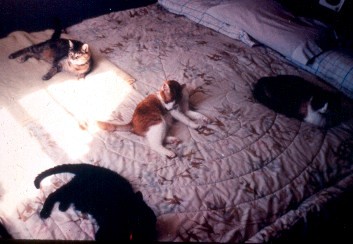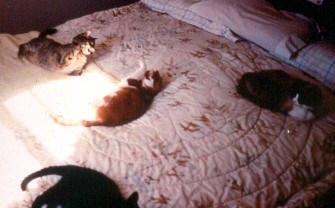Our good friend Mel sent us a sequence of photos of her four cats that are both interesting and enlightening.
The first one – shown here – shows her four cats spread out on her bed enjoying the sunshine pouring through the windows. They’re all quietly co-existing, each in a different part of the bed.

The next photo – below – shows two of the cats swatting at each other. What happened?

One of the cats, who had been lying on his left side facing away from the others, rolled over to lie on his right side. This put him closer to one of the other cats and this led to the spat. Why should such an innocent movement cause a disagreement?
Cats, like most animals and people, are surrounded by an invisible envelope we call that individual’s personal space. Most animals don’t like that space invaded by others, except under certain circumstances.
When it is invaded, the animal either moves away to put the intruder outside the personal space envelope, or threatens or attacks to move the intruder away. This is what happened to Mel’s cats. When the one rolled over, it put her in the personal space of her neighbor and the neighbor attacked to drive the intruder away.
The size of the personal space as well as how the individual responds to the invasion depends on many factors, including the species of animal. Cats, a more solitary species, have a bigger personal space than dogs of the same size which are a more social species.
The response also depends on the situation and the relationship between the individuals. Our most recent cat, the late great Buffett, has a much smaller personal space with us (he lets us get closer) than he does with our two dogs. He doesn’t usually let them get so close. Also, Buffett’s personal space with us is much larger when we have the nail clippers in our hands than when we have a bit of baked chicken.
Some of the fighting that occurs between cats living together seems to be caused by invasions of personal space rather than dominance issues, possessiveness or even territoriality. Many, but not all, cats are tolerant of other cats if the others don’t come too close.
But some home environments, shelters and research facilities don’t give cats enough room to spread out and this can lead to distress, threats and fighting. Providing plenty of space where cats can get away from each other can reduce distress and reduce fighting. One way to do this in limited indoor environments is to provide vertical space. Adding perches, kitty climbers, and even cat walks along the walls can help cats stay out of the personal space of others and help prevent conflicts.
Personal space is important to people as well as cats. Watch how people tend to spread themselves out the next time you are on a crowded bus or subway train. You can often tell which people are friends and which are strangers by how close or how far apart they are to others.
Leave A Response